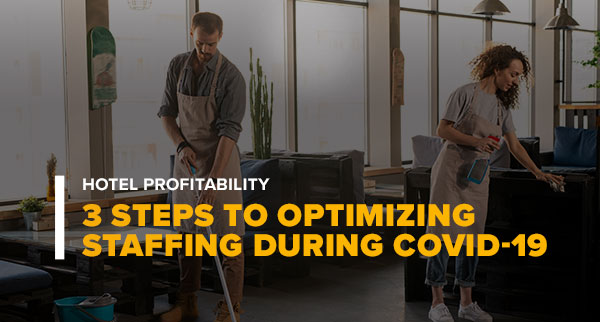July 2020 — Published in Hotel Business Week — By Mark Heymann, CEO, UniFocus - As we continue on through the coronavirus pandemic, the hospitality industry faces a unique set of challenges that will require hotels to take an adaptive approach to staffing. A new reality exists as occupancy levels are now entirely more difficult to predict. Uncertainty about the virus has made it nearly impossible to anticipate the expected occupancy levels for next week, next month or next year. Without that visibility, money—lots of money—can be lost.
One example: A hotel creates its weekly staff schedule on Monday based on the 700 incoming guests expected for the upcoming weekend. But then, a COVID-19 spike on Wednesday causes widespread travel cancellations that decrease occupancy by 60 percent—significantly reducing the number of employees needed to maintain operational efficiency. However, the hotel fails to adjust its schedule accordingly, and ends up paying for the labor costs of the 700-guest occupancy volume it originally expected. In turn, its profitability suffers severely.
Another example: Around 50 percent of a hotel’s staff is comprised of parents who have additional childcare needs in light of pandemic-related school closings. With their children home during daytime hours, these employees aren’t able to work traditional five-day, 40-hour schedules anymore. However, the hotel refuses to adapt its scheduling processes to address half of the staff’s new circumstances, and now deals with repeated call-offs each week that weaken the hotel’s service quality, ability to retain employees, and—most of all—staffwide employee engagement.
That’s an inside look at some of the newfound problems surfacing across the country as hotels have started to reopen. With profit margins unprecedently tight, companies just don’t have the wiggle room to overspend on labor or provide poor service and still expect to make it to the other side. Considering the circumstances won’t change until an effective vaccine is developed likely in 2021, there simply isn’t a margin for error in the foreseeable future.
A solution to complex staffing challenges does exist and can be utilized to address these issues. It’s derived from an optimized approach to labor management, one tailored to a pandemic recovery process through task-oriented labor practices, flexible scheduling processes and real-time adjusted staffing to service levels. Replacing old outdated labor techniques with these proactive strategies will enable hotels to quickly navigate fluctuating guest volumes while en route to the consistent profitability levels essential for recovery.
Task-Oriented Labor
In order to remain profitable during interchanging low volumes, hotels will need to cross utilize their staff so employees can fulfill multiple positional responsibilities during a single shift. But cross utilization isn’t simple—it requires a switch from job class-oriented staffing to task-oriented staffing. The more versatile the employee, the better. Employees who can efficiently perform a diverse range of tasks during a single shift will be key, switching from front of house responsibilities to serving during peak dining hours to room-delivery, all in one day. Regardless of responsibilities, employees must be trained for tasks rather than positions. A versatile, cross utilized staff is what will provide hotels with the adaptability needed to have the right labor costs without sacrificing service quality.
Flexible Scheduling
Scheduling is the second major staffing concept that was impacted by the pandemic. In reality, the average employee’s availability has been significantly reduced; parents who now have children home due to school closings, a manager forced to take a two-week leave of absence to self-quarantine after coming in contact with someone COVID-19 positive, or a dishwasher who requested a three-day schedule because, with a family to provide for, he needs to reduce his personal out-of-pocket expenses while watching his children. In each of these cases, hotels would need to rely on flexible scheduling practices that allow for quick shift adjustments on a case-by-case basis. The idea is about creating schedules tailored to the needs of the employees that keep the hotel operating. Offering employees the option to work three 12-hour shifts in one week, or four 10-hour shifts, or the standard five-day, 8-hour shift week will be vital—all while giving them the option to temporarily cut back without fear of their job being in jeopardy. Amidst hectic times, flexibility in when and how long employees work will give hotels added leverage to their labor management strategy. Obviously, in some environments there is an overtime impact after eight hours, but this should be negotiated away for a period of time to focus on the 40-hour per-week rule.
Staffing to Service Levels
A third way hotels can create an optimized staffing approach for COVID-19 recovery is by reviewing the expected volumes of the next three days and comparing them to the original forecast used to create the schedule. A nimble organization will have the greatest opportunity for success. Predictions will fluctuate in the short term and must be responded to quickly. An effective system can instantaneously calculate the difference between the schedule and the new staffing requirements, whether the needs are trending up or down. Once a variance is determined, rapid communication for additional or reduced coverage can be affected through mobile communication technologies to on-call employees. A wide network of part-time, on-call employees who agree to lighter minimum shift requirements allows hotels to achieve profitability more quickly by adjusting staffing costs to service levels in real-time.
It’s time to welcome new, innovative labor-management practices that are optimized to the current state of hospitality. For hotels, the road to COVID-19 recovery will be an ongoing process that, frankly, is to some degree out of their control. The virus will determine when the industry officially returns to prosperity. Though in the meantime, the steps hotels take now will determine their ability to regain stability when that day does finally come.
Click here to read the original article in Hotel Business Week.







